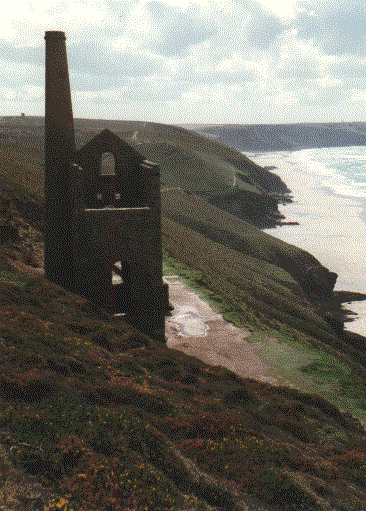|
| |
Why in the 1880s and 1890s did so many
families, amongst them the Sleemans, emigrate to South Africa, Canada, the United States,
Australia and elsewhere?
Today Cornwall is apparently prosperous and full of holiday
makers, but the European Community recognises the economic depression in the Cornwall of
1999. If you had been in London during the spring of 1999, you could have seen at the
Cottesloe Theatre (part of the National
Theatre complex near Waterloo) a play co-produced by the Kneehigh Theatre of Cornwall.
"The Riot" is loosely based on a disturbance which occurred in the port
of Newlyn, Cornwall on Monday May 18th 1896. Although the tale is about Cornish
fishermen who attended chapel on Sunday, while "Yorkies" fished for mackerel,
there is a strong social comment on the "powerful few" who closed tin mines and
put thousands out of work in Cornwall. Large steam powered fishing boats were taking over
from the small labour intensive sail boats.
Maps: Penzance
Camborne,
Falmouth & Truro Bodmin
& St Austell Padstow
& Wadebridge
Liskeard,
Plymouth & Tavistock Launceston
Bideford
& Holsworthy Barnstaple
Okehampton
Tavistock
 |
Wheal Mine near St Agnes Head
(north of Redruth)
The Cornish tin and copper mines were often
deep and stretched out under the sea, with mighty steam winding engines
& pumps to keep the workings dry. [You can visit a restored engine now owned by
the National Trust at Levant
and the Gevor Museum
near St Just in West Cornwall] Cornish tin is hard won, with little ore and much
spoil. The tin in Canada and particularly the alluvial tin on the Malay Peninsula was much
less expensive to process. The last Cornish tin mine (Old Crofty) at Camborne after
closing down over the last two years and has re-opened in early 1999. The price of
tin on world markets reduced the profit for mine owners in the late 1800s and made
investment in new machinery difficult to justify, even though the tin seams are not
exhausted. Families, who had worked in the mines for generations suddenly found
themselves out of work.
There were numerous local inventions. The
world's first safety fuse was made near Camborne. Richard Trevithick
(1771-1833) built the first high-pressure steam engines. Important iron foundries
were established to build steam engines for mine pumping. Bodmin had a steam railway
two years before London. |
Changes to the production of food and farming had begun to
reduce prices and jobs. The coming of steam trains had given some advantage, but
Cornwall is a long way from the main areas of population in London and the Midlands.
One of the few remaining industries is the excavation of the special Kaolin clays in the
St Austell area for use in making fine bone china. A Plymouth Quaker chemist,
William Cookworthy, patented the process and started a small pottery in 1768. The
area was at its busiest in the 1830s to 1860's but many pits closed in the 1870s. You can
visit the Wheal Martyn Museum at Carthew near St Austell.
In "The Riot" one of the main characters (Harriet
Screetch) relates how her three brothers had been made redundant at the Botallack mine
near St Just at the most westerly point of Cornwall. They had refused the offer of
the mine owner to pay their ticket to emigrate. Like many miners they had travelled
in search of work [my own family come from the coal mining areas of South Wales and then
the Forest of Dean] but had eventually been forced to leave their families to find work
abroad, using the only skills they possessed. Her brothers had paid their passage to
Bulawayo. Her brother Israel had taken weekend work as a soldier in Bullawayo and had been
killed fighting natives. Harriet blames the mine owner for her brother's death. Women who
had worked in the mines or breaking rock to release the ore were not happy working as
maids for the few well off families. For many it was the workhouse, crime or
emigration.
|






